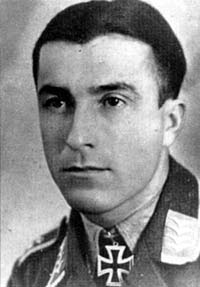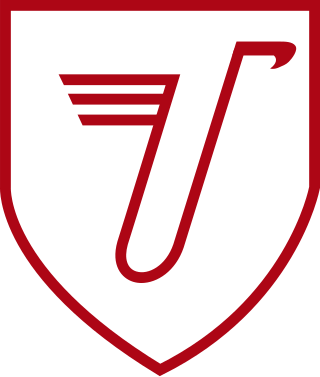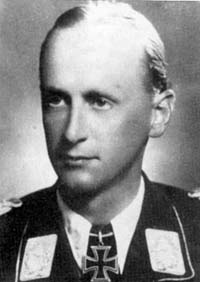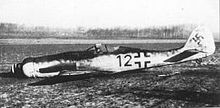
Walter Nowotny was an Austrian-born fighter ace of the Luftwaffe in World War II. He is credited with 258 aerial victories—that is, 258 aerial combat encounters resulting in the destruction of the enemy aircraft—in 442 combat missions. Nowotny achieved 255 of these victories on the Eastern Front and three while flying one of the first jet fighters, the Messerschmitt Me 262, in the Defense of the Reich. He scored most of his victories in the Focke-Wulf Fw 190, and approximately 50 in the Messerschmitt Bf 109. Nowotny scored an "ace in a day" on multiple occasions, shooting down at least five airplanes on the same day, including two occurrences of "double-ace in a day" in mid-1943.

Jagdgeschwader 52 was a German World War II fighter Geschwader (wing) that exclusively used the Messerschmitt Bf 109 throughout the war. The unit originally formed near Munich in November 1938, then moved to a base near Stuttgart. JG 52 became the most successful fighter-Geschwader of the war, with a claimed total of more than 10,000 victories over enemy aircraft during World War II. It was the unit of the top three scoring flying aces of all time, Erich Hartmann, Gerhard Barkhorn and Günther Rall.

Otto Kittel was a German fighter pilot during World War II. He flew 583 combat missions on the Eastern Front, claiming 267 aerial victories, making him the fourth highest scoring ace in aviation history according to authors John Weal and Jerry Scutts. Kittel claimed all of his victories against the Red Air Force.
Hans Ekkehard Bob was a German fighter pilot, serving with the Luftwaffe. During World War II, Bob flew approximately 700 combat missions, and claimed 60 victories; 37 of which were on the Eastern Front.

Johannes "Hannes" Otto Trautloft was a German Luftwaffe military aviator during the Spanish Civil War and World War II, and general in the postwar German Air Force. As a fighter ace, he is credited with 58 enemy aircraft shot down, including 5 in Spain, 8 on the Western Front and 45 on the Eastern Front of World War II.

Jagdgeschwader 3 "Udet" was a Luftwaffe fighter wing of World War II. The Geschwader operated on all the German fronts in the European Theatre of World War II. It was named after Ernst Udet, an important figure in the development of the Luftwaffe, in 1942.

Kurt Bühligen was a Luftwaffe wing commander and fighter ace of Nazi Germany during World War II. He was credited with 112 enemy aircraft shot down in over 700 combat missions. His victories were all claimed over the Western Front and included 24 four-engine bombers and 47 Supermarine Spitfire fighters.

Kurt "Kuddel" Ubben was a German Luftwaffe wing commander and military aviator during World War II, a fighter ace listed with 110 aerial victories—that is, 111 aerial combat encounters resulting in the destruction of the enemy aircraft—claimed in approximately 500 combat missions.

Werner Schröer was a German military aviator and wing commander in the Luftwaffe during World War II. As a fighter ace, he was credited with 114 enemy aircraft shot down in 197 combat missions. He claimed twelve aerial victories on the Eastern Front with the remaining claims filed over the Western Allies, including 26 four-engine heavy bombers.

Anton "Toni" Hackl was a German Luftwaffe military aviator during World War II, a fighter ace credited with 192 enemy aircraft shot down in over 1,000 combat missions. The majority of his victories were claimed over the Eastern Front, with 87 claims over the Western Front. Of his 87 victories over the Western Allies, at least 32 were four-engined bombers, a further 24 victories were unconfirmed.

Robert "Bazi" Weiß was an Austrian-born Luftwaffe fighter pilot during World War II. As a fighter ace, he was credited with 121 aerial victories claimed in more than 471 combat missions. Weiß claimed the majority of his victories over the Eastern Front, and 26 over the Western Allies, including three four-engined heavy bombers.

Gerhard Homuth was a World War II Luftwaffe fighter ace. He scored all but two of his 63 victories against the Western Allies whilst flying the Messerschmitt Bf 109, and was one of the top scoring aces in the North African campaign.

Heinz Lange was an officer and pilot in the Luftwaffe of Nazi Germany during World War II who briefly commanded fighter wing Jagdgeschwader 51. He was a recipient of the Knight's Cross of the Iron Cross.

Reinhard Seiler was a Nazi German Luftwaffe Major and ace of the Spanish Civil War and World War II, commander of Jagdgeschwader 104 and a winner of the Knight's Cross of the Iron Cross with Oak Leaves; for the fighter pilots, it was a quantifiable measure of skill and combat success. Reinhard Seiler was credited with 100 victories during World War II, over the course of about 500 combat missions. He recorded an additional 9 victories during the Spanish Civil War.

Jagdgeschwader 4 was a Luftwaffe fighter wing of World War II.
Erich Hohagen was a German general in the Bundeswehr. During World War II, he served as a fighter pilot in the Luftwaffe. A fighter ace, Hohagen was credited with 56 aerial victories and was a recipient of the Knight's Cross of the Iron Cross, the highest award in the military and paramilitary forces of Nazi Germany during World War II.

Franz Eisenach was a German fighter ace during World War II and a recipient of the Knight's Cross of the Iron Cross of Nazi Germany. He was credited with 129 aerial victories claimed in 319 combat missions, all on the Eastern front of the Second World War.

Siegfried Schnell was a German military aviator who served in the Luftwaffe during World War II. As a fighter ace, he was credited with 93—that is, 93 aerial combat encounters resulting in the destruction of the enemy aircraft—claimed in an unknown number of combat missions. He had three victories on the Eastern Front and 90 over the Western Allies, including 12 four-engine bombers.
Alfred Teumer was a German Luftwaffe military aviator and fighter ace during World War II. He is credited with 76 aerial victories claimed in over 300 combat missions. This figure includes 66 aerial victories on the Eastern Front, and further ten claims over the Western Allies.
Karl Borris was a World War II Luftwaffe military aviator and test pilot. As a flying ace, he is credited with 43 victories, all of them over the Western Front, for which he was awarded the Knight's Cross of the Iron Cross, the highest award in the military and paramilitary forces of Nazi Germany during World War II. Borris was involved in the introduction of the Focke-Wulf Fw 190 to front line service. Borris and 30 other pilots, technicians and engineers extensively tested the Fw 190 and their input was used in the decision to continue the project.

















